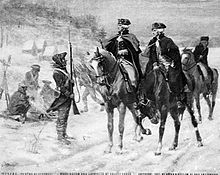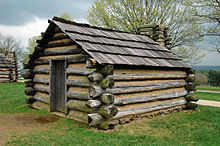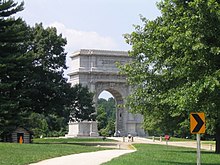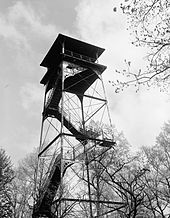
Louis Antoine Jean Le Bègue de Presle Duportail was a French military leader who served as a volunteer and the Chief Engineer of the Continental Army during the American Revolutionary War. He also served as the last Secretary of State for War and first Minister of War during the beginning of the French Revolution.

Morristown National Historical Park is a United States National Historical Park, headquartered in Morristown, New Jersey, consisting of four sites important during the American Revolutionary War: Jockey Hollow, Ford Mansion, Fort Nonsense, and Washington's Headquarters Museum.
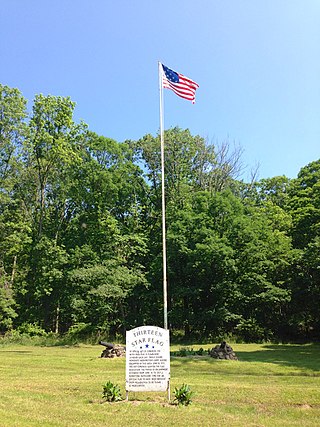
"Middlebrook encampment" may refer to one of two different seasonal stays of the Continental Army in central New Jersey near the Middlebrook in Bridgewater Township in Somerset County. They are usually differentiated by either the date of the encampment or their chronological order.

Jockey Hollow is the name for an area in southern Morris County, New Jersey farmed in the 18th century by the Wick, Guerin and Kemble families. The origin of the name is still uncertain, but was used as such at the time of the American Revolution. For most of the Revolutionary War, it was used by portions of Continental Army as a winter camp site, and it housed the main Continental Army during the "Hard Winter" of 1779–80, believed to be the harshest winter in recorded history.

Pennsylvania was the site of many key events associated with the American Revolution and American Revolutionary War. The city of Philadelphia, then capital of the Thirteen Colonies and the largest city in the colonies, was a gathering place for the Founding Fathers who discussed, debated, developed, and ultimately implemented many of the acts, including signing the Declaration of Independence, that inspired and launched the revolution and the quest for independence from the British Empire.

The Valley Forge Pilgrimage and Encampment is the oldest annual scouting event in the world. It was first held on February 22, 1913, and has been held every year since. The event is hosted by the Cradle of Liberty Council and commemorates the soldiers of the Continental Army who braved the winter of 1777-78 at Valley Forge. Each year more than 2,000 brave the winter chill of the Delaware Valley to participate.

Washington's Headquarters at Valley Forge, also known as the Isaac Potts House, is a historic house that served as General George Washington's headquarters at Valley Forge during the American Revolutionary War. The building, which still stands, is one of the centerpieces of Valley Forge National Historical Park in Southeastern Pennsylvania.

The National Memorial Arch, is a memorial arch located in Valley Forge National Historical Park of Upper Merion Township, Pennsylvania. The monument honors the arrival of General George Washington and the Continental Army at Valley Forge, which was the site of their military camp during the winter of 1777–78. Construction on the structure began in 1914 and it was dedicated in 1917.
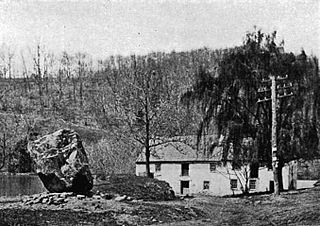
Gulph Mills is an unincorporated community that is located in Upper Merion Township, Montgomery County, Pennsylvania. It is served by the Upper Merion Area School District.

Valley Forge functioned as the third of eight winter encampments for the Continental Army's main body, commanded by General George Washington, during the American Revolutionary War.

Nero Hawley was an African-American soldier who was born into slavery in North Stratford, Connecticut, and later earned his freedom after enlisting in the Continental Army in place of his owner, Daniel Hawley, on April 20, 1777, during the American Revolution. His life is featured in the 1976 book From Valley Forge to Freedom, which also notes other areas of present-day Trumbull, Connecticut associated with Hawley.

The General Friedrich Von Steuben Headquarters is a historic house on Pennsylvania Route 23 in Valley Forge National Historical Park in Chester County, Pennsylvania. Built about 1770, it has been advanced as a possible residence of Baron Friedrich von Steuben (1730-1794), the Prussian drill-master of Continental Army troops during the 1777-78 Valley Forge encampment. The house, which is a partial reconstruction, was declared a National Historic Landmark in 1972.

Moland House is an old stone farmhouse built around 1750, by John Moland, a Philadelphia and Bucks County lawyer. Although physically located in Hartsville, Warwick Township, Bucks County, Pennsylvania, its mailing address is in Warminster Township, Pennsylvania.
The Pluckemin Continental Artillery Cantonment Site in Pluckemin, New Jersey, at the southern section of Bedminster Township, New Jersey, holds historic American Revolutionary War importance as the Continental Army's artillery winter cantonment during the winter of 1778–79. It was nestled on the western side of the Second Watchung Mountain just to the North of the village of Pluckemin. The major significance of the site lies with the very different picture it yields of military organization during the Revolutionary War, although some point to it as the birthplace of the American military academy, 24 years prior to the founding of the United States Military Academy at West Point.

Camp-Woods, is a historic estate with associated buildings located at Villanova, Delaware County, Pennsylvania and built on a 400 ft (120 m) high spot which had been a 200-man outpost of George Washington's Army during the Valley Forge winter of 1777–78. The house, built between 1910 and 1912 for banker James M. Willcox, is a two-story, brick and limestone, "F"-shaped house in an Italianate-Georgian style. It measures 160 ft (49 m) in length and 32 ft (9.8 m) deep at the "waist." It has a slate roof, Doric order limestone cornice, open loggia porches, and a covered entrance porch supported by Doric order columns. The house was designed by architect Howard Van Doren Shaw (1869-1926). The property includes formal gardens. Its former carriage house is no longer part of the main estate. The original tennis court is now also a separate property named "Outpost Hill". The Revolutionary encampment is marked by a flagpole in a circular stone monument at the north-western edge of the property. The inscription reads, "An outpost of George Washington's Army encamped here thro the winter of Valley Forge 1777-1778".
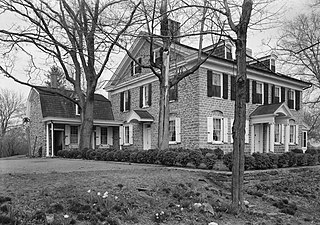
Moore Hall, also known as the William Moore House, is an historic, American home that is located in Schuylkill Township, Chester County, Pennsylvania.

The David Havard House, also known as the Former Quarters of Lee and Bradford, is a historic home located near Valley Forge in Tredyffrin Township, Chester County, Pennsylvania. During the American Revolutionary War, it served as quarters for several of George Washington's senior officers.

General George Washington used a pair of campaign tents throughout much of the American Revolutionary War. In warm weather, he used one for dining with his officers and aides, and the other as his military office and sleeping quarters. Canvas panels and poles from both tents survive, and are currently owned by four separate historical organizations.
W. Herbert Burk (1867-1933) was an Episcopal priest and founding vicar of the Washington Memorial Chapel in the Valley Forge National Historical Park. He is known for assembling, over the course of many years, the collection of Revolutionary War artifacts that form the core of the collection of the Museum of the American Revolution in Philadelphia, and for his work to preserve Valley Forge, the site of an important Revolutionary War army encampment.
The Centennial and Memorial Association of Valley Forge was incorporated in Montgomery County, Pennsylvania in 1878, with the objective of saving, acquiring, restoring, and preserving General Washington's Valley Forge Headquarters and surrounding acreage as parcels of it became available.



